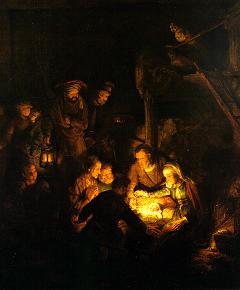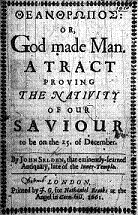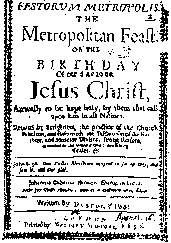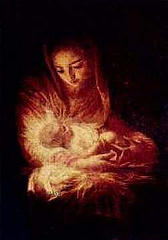Augustine's Christmas Sermons
The Nativity, December 25th,
and the Solstice
"Hence it is that He
was born on the day which is the shortest in our earthly
reckoning and from which subsequent days begin to increase in
length. He, therefore, who bent low and lifted us up chose the
shortest day, yet the one whence light begins to increase.”
Sermon 194
Augustine (A.D. 354-430) was biship of Hippo, north Africa. In his piece on the Trinity, Augustine states regarding the birth of Christ:
"He was born, according to tradition, upon December the 25th."
Augustine’s Christmas sermons (Sermons
185-196) are short, usually only a few paragraphs; several
employ metaphors associating the birth of Christ and the
gospel proclamation with the sun, the winter solstice, and the
increase of light (Sermons 186, 188, 189, 190, 192, 194).
When Augustine wrote, the solstice occurred
December 21st. The Julian calendar fixed the solar
year at precisely 365 ¼ days. The actual length of the solar
year is 365 days, 5 hours, 48 minutes, 45 seconds, just better
than eleven minutes shorter than the Julian year. This
difference means that in the space of 131 years, the Julian year
fell behind the solar year by one day, the solstices and
equinoxes occurring a day before their civil date in the
calendar. By A.D. 325, the solstice and equinox anticipated
their civil dates by four days. Hence, to establish the uniform
observance of Easter (Pasche), which is regulated by the vernal
equinox, the Council of Nicaea fixed the ecclesiastical date of
the spring equinox at March 21st to coincide with the
actual astronomical event. But since the four points of the year
stand in fixed relation to one another, the winter solstice
necessary occured four days earlier at December 21st
This means that when Augustine preached his
Christmas sermons, actual connection between December 25th
and the winter solstice had ceased to exist as much as four
hundred years earlier. Selden
(Theanthropos) takes this as evidence that belief in the December 25th
birth of Christ must have originated very early on, in apostolic
times, while the association of the solstice with December 25th
was still popularly retained, long before Nicaea when the
distance between these events was widely known and understood.
In other words, it is at the point where these three coincided –
the Nativity, December 25th, and the solstice–that
the association must have risen, not in later centuries when
these three had grown progressively further apart.
______________________________

Adoration of the Shepherds
All rights reserved.
 John Seleden’s
John Seleden’s




